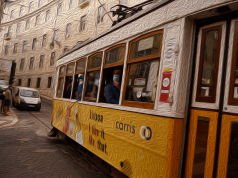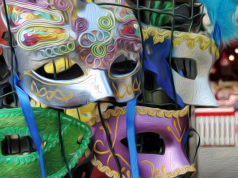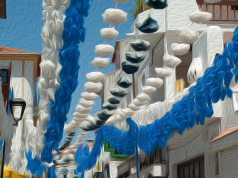Ahoy, travelers and flag enthusiasts!
Are you ready to embark on a journey to discover the secrets of one of the oldest flags in the world? We’re setting sail to explore the Portuguese flag – an emblem of national pride and centuries of history. From the colors of hope and blood to the mysterious armillary sphere, this flag has a story to tell.
But we won’t stop at the essentials. No, no, we’ll also dive into some fun facts that will make you the life of the next trivia night.
So hoist the anchor, and let’s dive into the world of the Portugal flag!
What does the Portuguese Flag mean?
[This section is for those of you that don’t have the patience. Here it is in a nutshell]
The Portuguese flag is a proud symbol of the nation’s rich history and vibrant culture. But what does it mean? Here are the facts:
- The Portuguese flag of today was designed in 1910, after the revolution that overthrew the monarchy and proclaimed a republic on October 5. To get rid of monarchy symbols, a new national flag was created.
- The flag was created by a special team including painter Columbano Bordalo Pinheiro and writer Abel Botelho. They were tasked with designing a flag that symbolized the new Portugal.
- The national flag as we know it is divided vertically into two main colors, green and red. The green part is smaller. On the center of the flag, you will find a yellow armillary sphere and a red shield.
But what do these elements represent? Let’s break it down:
- The green color represents hope for the future, and the red color symbolizes the blood shed by the Portuguese people throughout their history.
- The armillary sphere is a nod to Portugal’s rich maritime history. It was an instrument used by navigators to measure the position of the stars and guide their ships. The sphere on the flag is surrounded by seven smaller white spheres that represent the heavens
- The red shield is a symbol of strength and bravery, and it features a white quina, or five shields. This represents the Portuguese victories in battle and their readiness to defend their country.
Together, the elements on the Portuguese flag tell the story of a nation that is proud of its past but always looking toward the future. It’s a symbol of hope, strength, and the enduring spirit of the Portuguese people.
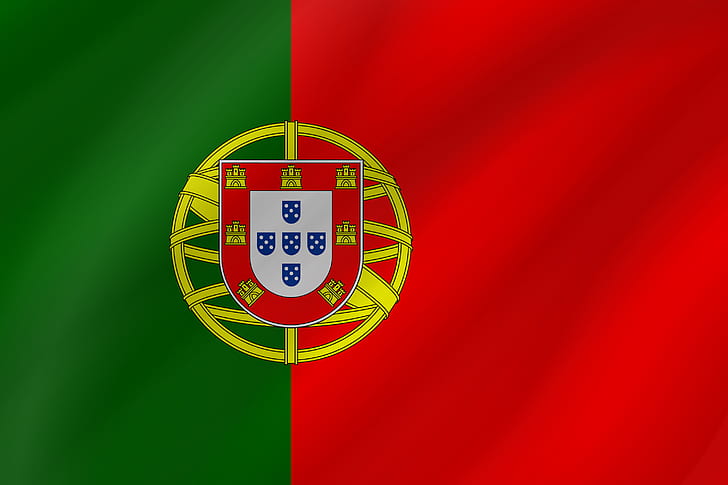
[Now for those of you, the curious bunch, that want to read the whole story and the details…]
Essentials
The history of Portugal’s national flag is as rich and colorful as the flag itself. The design of the flag has undergone numerous changes throughout Portugal’s long history, with each color and symbol holding significant meaning. Depending on the wars, discoveries, or travels of the time, the figures on the flag changed too. However, despite its many transformations, each version of the Portuguese flag has featured the iconic Portuguese shield, a crucial component of the country’s family crest. The seven castles on the flag represent Portugal’s conquests over its foes during the reign of Afonso III in the 1200s, while the little blue shields symbolize the five wounds of Christ. The meaning behind the flag may not be complicated, but its history is fascinating!
Proportion
The current Portuguese flag has a rectangular shape. It has two main background colors: green and red. The green part of the flag is on the hoist and the red is on the fly. Around the center of the flag, there is the national coat of arms. There is a yellow armillary sphere and a Portuguese shield placed upon the sphere.
Date Adopted
The latest version of the flag was officially adopted on June 30th, 1911. This was around a year after the constitutional monarchy’s downfall. It was accepted as the new Portugal national flag of the First Portuguese Republic.
Portugal Flag History and Background
October 5th, 1910 – the date that marked a revolution in Portugal’s history. With it came a pressing need to replace the symbols of the monarchy. This included Portugal’s flag and anthem.
The old flag was blue and white, but there was disagreement about the change of colors. One reason for this was religious concerns, as blue was the color of “Nossa Senhora da Conceição”, crowned Queen and Patroness of Portugal by King John IV. Republicans, on the other hand, believed that it was necessary to secularize the state.
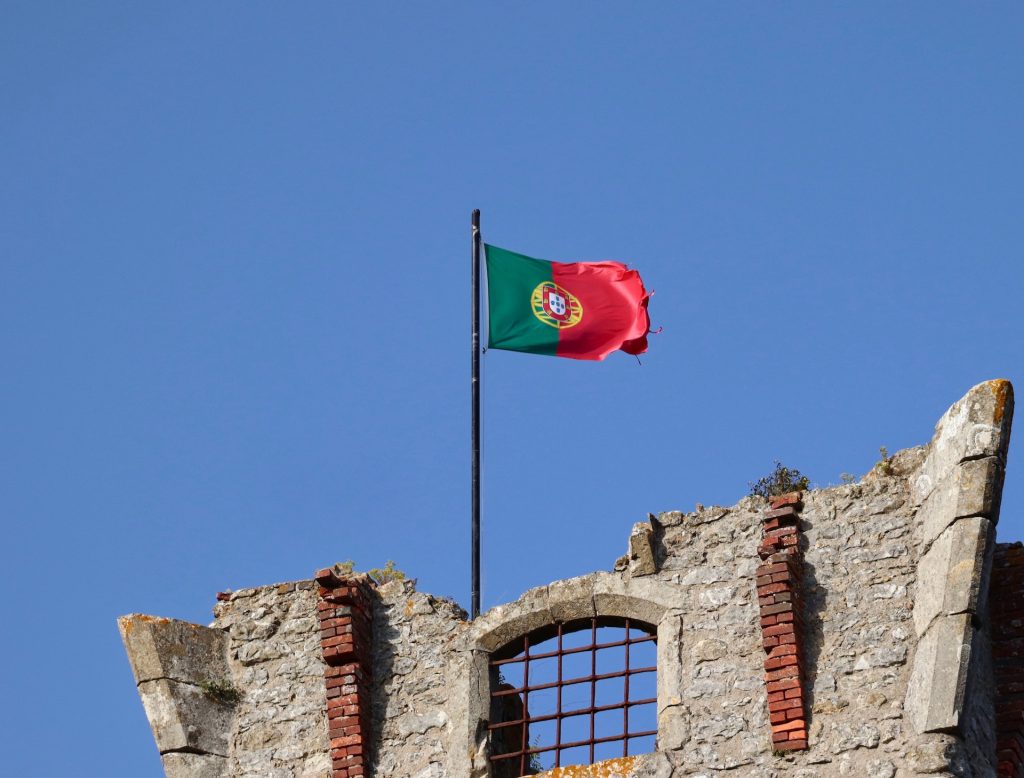
Rodrigo Curi / Unsplash
After numerous discussions, a governmental commission was formed on October 15th, 1910. The commission chose the red and green colors of the Portuguese Republican Party. These colors were present during the 1891 insurrection and the monarchy-overthrowing revolution in Lisbon. The commission believed that the colors had connotations of battling, conquest, burning, and joy. They also stated that the white color on the shield was “a beautiful and fraternal color, into which all other colors merge themselves, the color of simplicity, of harmony and peace”.
The armillary sphere was already present under the reign of John VI and had connotations with Portuguese maritime history. The shield was regarded as one of the “most vigorous symbols of national identity and integrity”.
Following these steps, the country started to produce the new flag at the National Rope House. It was officially presented on December 1st, 1910, which the government declared as “Flag Day”. The government also changed textbooks for children to explain the flag’s symbols in detail, hoping to ensure the whole country would accept the new flag.
The process of creating the new flag was a significant event in the history of Portugal. The old flag had been in use for centuries, and its replacement was a strong signal of the changes that were happening in the country. The new flag was also an essential symbol of the republic that had been established after the revolution. It represented the values and beliefs of the republicans, who wanted to create a new, secular, and democratic Portugal.
The new flag was received with mixed feelings by the Portuguese people. Some people were proud of the new flag and what it represented, while others were nostalgic for the old flag and what it represented. Over time, however, the new flag became accepted by the majority of the population, and it has been in use ever since. Today, it is a proud symbol of Portugal’s history, culture, and identity, and it is recognized all around the world.
Construction
Having a rectangular shape, the flag’s aspect ratio is 2:3. On the background, the green color spans 2⁄5 of the length, and the red spans 3⁄5. The national coat of arms (a white-rimmed national shield on top of a yellow armillary sphere) is placed over the border between both colors.

The armillary sphere is distant from equal sides of the upper and lower edges of the flag. The sphere is drawn in perspective. It has six edge-embossed arcs, four of which are big circles and two are small circles. The big circles represent the ecliptic, the equator, and two meridians. The last three are placed in a way that the intersections between every two arcs make a right angle.
The national shield is vertically centered over the sphere. It also has two main background colors: red on the edge of the shield, and white inside the shield like a miniature of the shield. The little white shield also has five more blue shields on it, arranged like a Greek cross. Each of them has five white bezants. The red bordure, on the other hand, has seven yellow castles; three on top (one in each corner and one in the middle), two in the middle, and two more on each side of the bordure. The big shield’s height and width are equal to 7⁄10 of the sphere’s diameter. The shield’s limits intersect the sphere.
Design
On June 19th, 1911, the Constituent Assembly approved the new design of the flag. The decree was also published in the government journal (diário do Governo) no. 141. The regulations of the decree were officially published in government diary no. 15 on June 30th.
Portugal Flag Colors
As indicated above, green and red are the predominant colors of the flag. In addition to these, we can also see the colors yellow, blue, and white as Portuguese flag colors.
The six basic colors of the Portuguese flag are green, red, yellow, blue, white, and black. Here are the charts for Portugal flag color codes;
Green Color Codes
| Hex | 046A38 |
| RGB | 4, 106, 56 |
| CMYK | 85, 3, 91, 44 |
| Pantone | 349 • |
| RAL | 6029 |
Yellow Color Codes
| Hex | FFE900 |
| RGB | 255, 233, 0 |
| CMYK | 0, 3, 97, 0 |
| Pantone | 803 • |
| RAL | 1026 |
Blue Color Codes
| Hex | 002D72 |
| RGB | 0, 45, 114 |
| CMYK | 100, 79, 0, 37 |
| Pantone | 288 • |
| RAL | 5002 |
Black Color Codes
| Hex | 000000 |
| RGB | 0, 0, 0 |
| CMYK | 0, 0, 0, 100 |
| Pantone | Black • |
| RAL | 9005 |
Symbolism
Ready to learn about the symbolism behind the Portuguese flag? Well, here are the three important symbols present on the Portuguese flag:
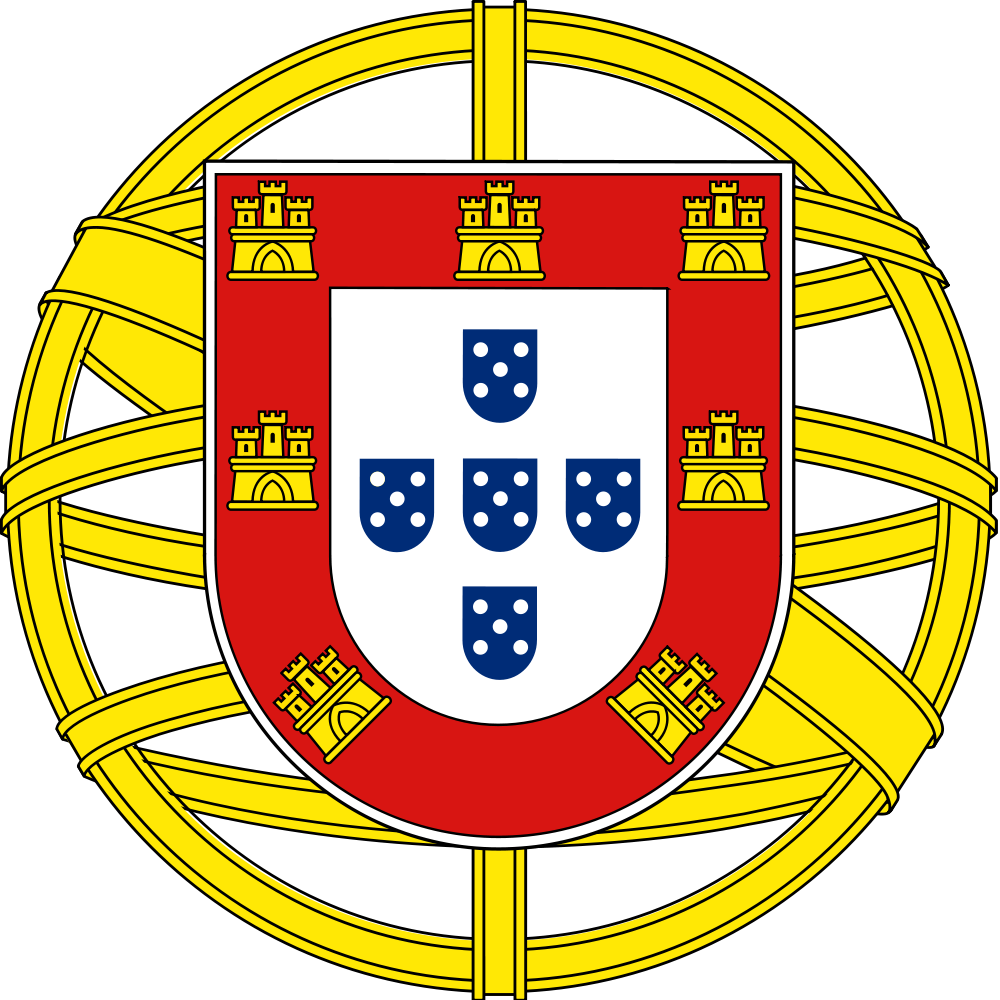
The field colors:
The background colors of green and red date back to the Estado Novo period. The green represents the hope of the Portuguese people, and the red represents the blood of people who died while serving the nation. These colors have existed in many historical banners during important periods, such as King John I’s banner and the naval flag during the Discoveries.
The armillary sphere:
The armillary sphere was important for the Portuguese sailors as an astronomical and navigational instrument during the Age of Discoveries. It became the symbol of that period of the nation, and it was included in King Manuel I’s personal banner. Later, it became a colonial symbol and an important element of the next Brazilian kingdom and Portuguese empire flag.
The national shield:
The Portuguese shield is placed over the armillary sphere and has existed in each historical flag except for the period of Afonso I. The five blue shields with five white bezants represent the five wounds of Christ when crucified and are associated with the “Miracle of Ourique.” The seven castles over the red border are regarded as a symbol of the Portuguese victories over Moorish enemies.
Here are some interesting facts about the symbolism behind the Portuguese flag:
- The green background version of the flag was popular among the rebellious during the 1640 revolution restoring Portugal’s independence from Spain.
- The label “Centro Democrático Federal ‘15 de Novembro’” represented one of many masonry-inspired republican clubs and was hoisted on Porto’s city hall balcony during the 1891 insurrection.
- A modified version of the Portuguese shield is present in the flag of the Spanish city of Ceuta, which is on the North African coast and used as the city’s coat of arms.
It’s fascinating to see how much history and meaning can be packed into a simple flag design!
Cool Facts about the Portuguese Flag
Here’s your chance to throw around some trivia to your friends. The Portuguese flag is one of the most recognizable national symbols in the world, but did you know these cool facts?
Meaning Behind the Colors
- Green represents hope for the future, and red represents blood during battle. Although the Portuguese Republic gave these reasons for the choice of colors, some believe there may be underlying reasons for the color choice that the government never made public.
The Symbolism of the Shield
- The oldest symbol on the Portuguese flag is the shield, which represents victories against the Moors. The seven yellow castles represent Moorish fortresses overthrown in battle, while the five smaller blue shields symbolize the five Moorish kings killed by Afonso I, the first king of Portugal.
The Armillary Sphere
- The armillary sphere is an important instrument for Portuguese navigators during the Age of Discoveries. They used it to navigate across the oceans, which is why the armillary sphere on the flag represents this important period in Portugal’s history.
Changes Over the Years
- At the beginning of its history, the Portuguese flag consisted of a coat of arms. The number of yellow castles changed a few times, and the shield’s shape also changed, with a crown above it, later replaced by the armillary sphere. The green and red background became part of the national flag only after the First Republic came into power, replacing the blue and white colors.
The Blue Cross
During a battle with the Moors, the count held a shield with a blue cross over white. This is where the white and blue that would once mark the last Portuguese monarch flag appeared at the center of the flag.
The Designers of the National Flag
- Three Portuguese pioneers designed the flag – Columbano Bordalo Pinheiro (painter), João Chagas (journalist), and Abel Botelho (writer).
Regional Flags
- Every district of Portugal has its own flag, including the Azores flag and Madeira islands flag.
Lisbon Flag
- Did you know that Lisbon has its own flag? The coat of arms on the flag tells the tale of how Saint Vincent became the city’s patron saint.
From its symbolism to its designers, the Portuguese flag is a fascinating national emblem with a rich history and cultural significance.
FAQ
What does the Portuguese Flag look like?
The flag of Portugal is instantly recognizable for its bold and striking design. The flag is divided vertically into two main colors, green and red, with the green part making up two-fifths of the flag and situated by the flagpole. Where the two colors meet, you’ll find the Portuguese coat of arms, featuring a white shield containing five small blue shields with white dots, within a red shield with seven small yellow castles, surrounded by yellow straps. The green color symbolizes hope for the future, while the red represents the blood of the nation. Interestingly, the five small blue shields represent the five Moorish kings who were defeated by the first King of Portugal.
What do the colors on the Portuguese flag represent?
Green represents the hope of people, and red represents the blood of people dying while serving their nation.
When was the most recent Portuguese flag adopted?
On June 30th, 1911, the current Portuguese flag design was adopted.
What are the important elements of the Portuguese flag?
There are three main elements of the Portuguese flag: the field colors, the armillary sphere, and the national shield. For the meanings of these elements, you can refer to the Symbolism section above.
Are there multiple Portuguese Flags?
No, there is only one official Portuguese national flag. The revolutionary flag went through multiple changes, transforming into the current version with the two colours and the reference to the royal arms. However, there are multiple regional Portuguese flags. Each of these regimental flags has its own key elements referencing various subjects such as the absolute monarch, the five arched crown, the old royal standard, the public domain, blood, history, Europe, Queen Maria II, or the Portuguese monarchists.
What is Portugal flag emoji?
🇵🇹 is the emoji for Portugal flag. These appear on systems that support them as a single emoji.


